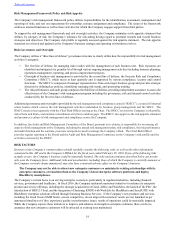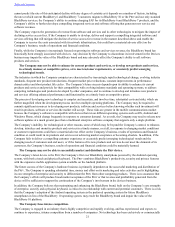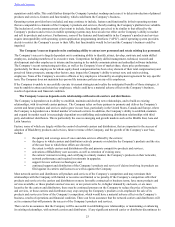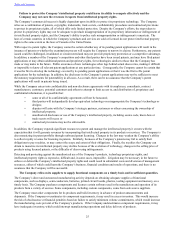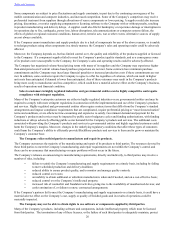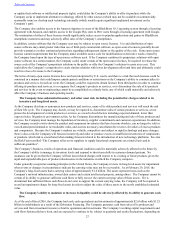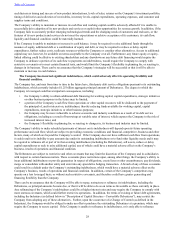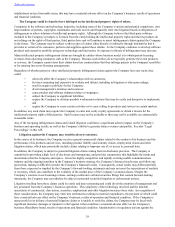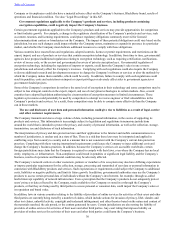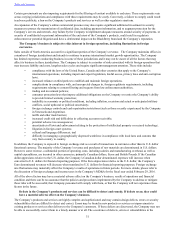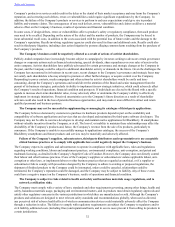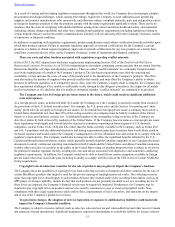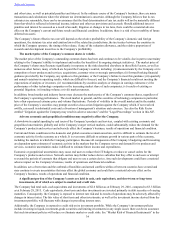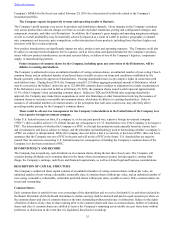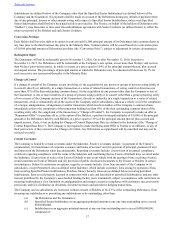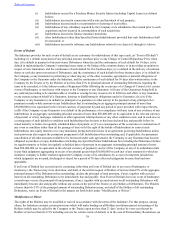Blackberry 2016 Annual Report Download - page 38
Download and view the complete annual report
Please find page 38 of the 2016 Blackberry annual report below. You can navigate through the pages in the report by either clicking on the pages listed below, or by using the keyword search tool below to find specific information within the annual report.
Table of Contents
29
indebtedness on less favourable terms, this may have a material adverse effect on the Company’s business, results of operations
and financial condition.
The Company could be found to have infringed on the intellectual property rights of others.
Companies in the software and technology industries, including some of the Company’s current and potential competitors, own
large numbers of patents, copyrights, trademarks and trade secrets and frequently enter into litigation based on allegations of
infringement or other violations of intellectual property rights. Although the Company believes that third-party software
included in the Company’s products is licensed from the entity holding the intellectual property rights and that its products do
not infringe on the rights of third parties, third parties have and will continue to assert infringement claims against the Company
in the future. The Company may be subject to these types of claims either directly or indirectly through indemnities that it
provides to certain of its customers, partners and suppliers against these claims. As the Company continues to develop software
products and expand its portfolio using new technology and innovation, its exposure to threats of infringement may increase.
Many intellectual property infringement claims are brought by entities whose business model is to obtain patent-licensing
revenues from operating companies such as the Company. Because such entities do not typically generate their own products
or services, the Company cannot deter their claims based on counterclaims that they infringe patents in the Company’s portfolio
or by entering into cross-licensing arrangements.
Regardless of whether patent or other intellectual property infringement claims against the Company have any merit, they
could:
• adversely affect the Company’s relationships with its customers;
• be time-consuming and expensive to evaluate and defend, including in litigation or other proceedings;
• result in negative publicity for the Company;
• divert management’s attention and resources;
• cause product and software shipment delays or stoppages;
• subject the Company to significant liabilities;
• require the Company to develop possible workaround solutions that may be costly and disruptive to implement;
and
• require the Company to cease certain activities or to cease selling its products and services in certain markets.
In addition, any such claim may require the Company to enter into costly royalty agreements or obtain a license for the
intellectual property rights of third parties. Such licenses may not be available or they may not be available on commercially
reasonable terms.
Any of the foregoing infringement claims and related litigation could have a significant adverse impact on the Company’s
business and operating results, as well as the Company’s ability to generate future revenues and profits. See also “Legal
Proceedings” in this AIF.
Litigation against the Company may result in adverse outcomes.
In the course of its business, the Company receives general commercial claims related to the conduct of its business and the
performance of its products and services, including product liability and warranty claims, employment claims and other
litigation claims, which may potentially include claims relating to improper use of, or access to, personal data.
In addition, the Company is subject to potential litigation claims arising from its disclosure practices. The Company is
committed to providing a high level of disclosure and transparency and provides commentary that highlights the trends and
uncertainties that the Company anticipates. Given the highly competitive and rapidly evolving mobile communications
industry and the ongoing transition in the Company’s business strategy, the Company’s financial results may not follow any
past trends, making it difficult to predict the Company’s financial results. Consequently, actual results may differ materially
from those expressed or implied by the Company’s forward-looking statements and may not meet the expectations of analysts
or investors, which can contribute to the volatility of the market price of the Company’s common shares. Despite the
Company’s cautions in each earnings release, earnings conference call and securities filings that contain forward-looking
statements, the Company may nevertheless be subject to potential securities litigation or enforcement actions.
Litigation resulting from these claims could be costly and time-consuming and could divert the attention of management and
key personnel from the Company’s business operations. The complexity of the technology involved and the inherent
uncertainty of commercial, class action, securities, employment and other litigation increases these risks. In recognition of
these considerations, the Company may enter into settlements resulting in material expenditures, the payment of which could
have a material adverse effect on the Company’s business, results of operation and financial condition. If the Company is
unsuccessful in its defense of material litigation claims or is unable to settle the claims, the Company may be faced with
significant monetary damages or injunctive relief against it that could have a material adverse effect on the Company’s
business, BlackBerry brand, results of operations and financial condition. Administrative or regulatory actions against the


